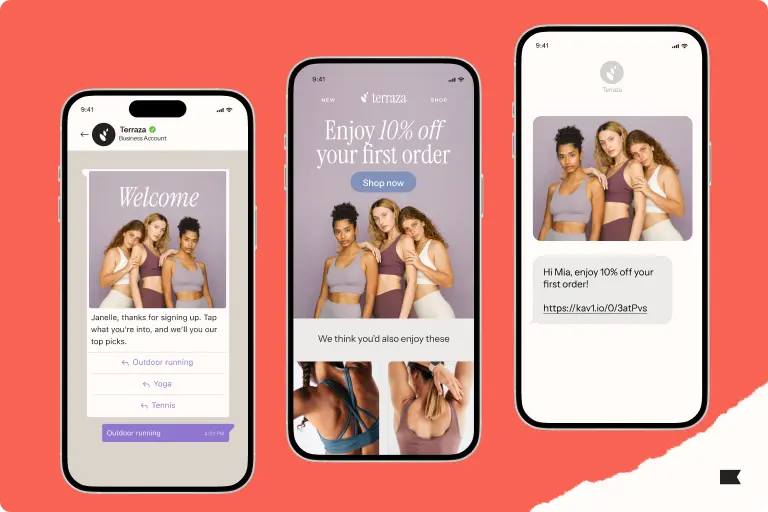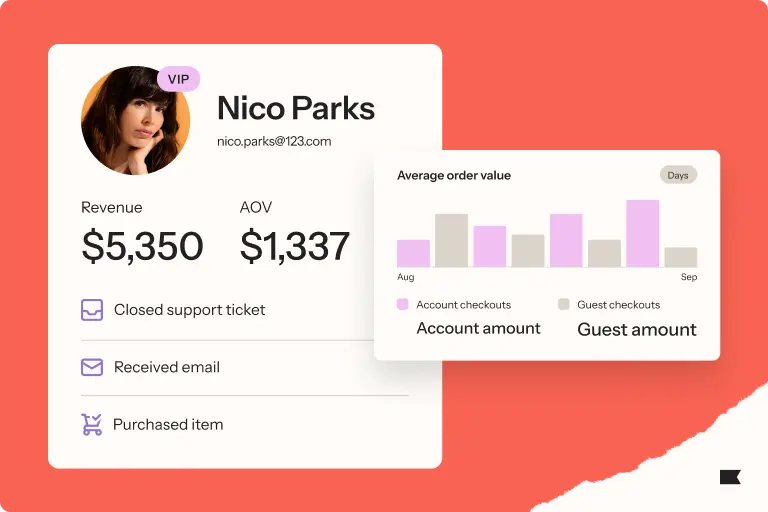Transform your WooCommerce store with Klaviyo: unlock value from your data immediately

If you sell on WooCommerce, you already know the value of running a store your way.
Now imagine unlocking even more potential with a marketing automation that grows your business using real-time data from your customers.
Klaviyo and WooCommerce have partnered to use your store data to create deeply personalized email, SMS, and mobile push messaging, along with product reviews that engage customers, drive sales, and grow your revenue.
WooCommerce, the engine behind 4 million stores, recently named Klaviyo their preferred marketing automation partner. Our integration changes the playbook for businesses of all shapes and sizes, helping you simplify your marketing and unlock new growth opportunities.
Over 15,000 WooCommerce merchants are already seeing the difference with Klaviyo. From small businesses to major brands like Tonal and Bloomscape, these brands are growing smarter, achieving an average ROI of 46x on their email and SMS campaigns.
Now, it’s your turn.
Whether you’re selling physical products, digital downloads, or services, this integration is your shortcut to smarter marketing and stronger customer relationships. The best part? This integration is available out of the box. No developers required.
Klaviyo marketing automation meets WooCommerce
The Klaviyo x WooCommerce integration brings powerful benefits to your WooCommerce store, equipping you with tools to simplify and elevate your marketing efforts. Here’s how Klaviyo and WooCommerce help you succeed:
- Real-time data syncing: All your customer data, like browsing habits, purchases, and preferences, flows seamlessly from WooCommerce into Klaviyo.
- Effortless personalization: Use that data to send tailored email and SMS campaigns that feel personal and relevant to every customer through product recommendations and dynamic coupons.
- Automated flows: Set it and forget it with pre-built templates and flows for cart abandonment, welcome messages, review requests, and more.
- Powerful analytics: Know exactly what’s working with detailed insights into campaign performance, so you can keep optimizing and growing.
In just a few clicks, you’ll be up and running with smarter, more impactful marketing.
Just look at WooCommerce merchant My Community Made, an online marketplace for handcrafted art, jewelry, and home décor. They turned to Klaviyo after struggling with Mailchimp’s limitations, including $0 in email-attributed revenue over a year. Within their first week on Klaviyo, they began driving email revenue, and today, Klaviyo powers 30% of their ecommerce revenue.
Why this matters for retail—and beyond
The Klaviyo x WooCommerce integration isn’t just a feature. It’s a fundamental shift in how WooCommerce merchants can approach growth. For retail businesses, it means:
- Driving more sales with personalization: Tailor every email and SMS to match customer preferences, making each interaction more meaningful.
- Streamlined automation: Automate key customer touchpoints like abandoned cart reminders and product review requests, so you can focus on scaling your business.
- Data-driven decision making: Use Klaviyo’s powerful analytics to understand what works and refine your strategy to maximize ROI.
Beyond retail, the flexibility of this integration allows for growth opportunities for other industries, such as hospitality, food and beverage, education, and more. If you can dream it, you can build it, and control your success as you grow. With smarter tools at your fingertips, you’ll find new ways to engage customers, nurture loyalty, and create new revenue streams.
Take Force of Nature, a natural cleaning brand that switched to Klaviyo for its seamless WooCommerce integration and unified email and SMS platform. With 49 live flows and granular segmentation, they grew revenue from flows 140% YoY.
Klaviyo has been the right platform for us to scale and meet our acquisition and LTV goals.
We use it to make sure we’re getting the right message to the right customer at the right time on the right channel. It’s absolutely the right choice.
How to get started
Ready to see the Klaviyo difference? Here’s how to get up and running:
- Install the Klaviyo plugin on your WooCommerce store.
- Sync your data seamlessly. No coding required.
- Build your first personalized campaign using Klaviyo’s intuitive templates and automation tools.
Need help? No problem. Check out our step-by-step guides, join our community of experts, or connect with our world-class support team.

Related content

Klaviyo welcomes Chano Fernández as Co-CEO to help accelerate global growth and lead the next era of AI-powered customer experiences.

Discover how cross-channel marketing and the rise of SMS shaped BFCM 2025. Learn why email + text orchestration drove record engagement, efficiency, and revenue.

AOV stayed strong during BFCM 2025 despite rising prices. Learn why average order values held steady, what drove pricing power, and how brands can protect margins.